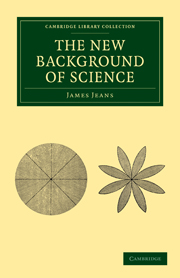Book contents
- Frontmatter
- Contents
- Preface to the First Edition
- Preface to the Second Edition
- Chapter I The Approach to the External World
- Chapter II The Methods of Science
- Chapter III The Framework of the External World—Space and Time
- Chapter IV Mechanism
- Chapter V The Texture of the External World—Matter and Radiation
- Chapter VI Wave-Mechanics
- Chapter VII Indeterminacy
- Chapter VIII Events
- Index
Chapter III - The Framework of the External World—Space and Time
Published online by Cambridge University Press: 07 September 2010
- Frontmatter
- Contents
- Preface to the First Edition
- Preface to the Second Edition
- Chapter I The Approach to the External World
- Chapter II The Methods of Science
- Chapter III The Framework of the External World—Space and Time
- Chapter IV Mechanism
- Chapter V The Texture of the External World—Matter and Radiation
- Chapter VI Wave-Mechanics
- Chapter VII Indeterminacy
- Chapter VIII Events
- Index
Summary
We have already pictured the new-born child trying to correlate the events and objects which affect its senses, thereby taking its first steps towards becoming a scientist. Gradually it makes the discoveries which we express by saying that the events can be arranged in time, and that the objects in which they appear to originate can be arranged in space. Thus space and time form a sort of framework for the sense impressions which the child receives from the external world. The child does not of course concern itself with metaphysical questions as to the fundamental nature of space and time, and neither shall we here; only the simplest properties of space and time, as perceived by us, are relevant at the present stage of our discussion.
Rudimentary Views of Space and Time
The child finds that the events of its day come in simple sequence, like beads on a string. The string is what we call time, and the order of events relative to one another can be fully described by the words “earlier” and “later”. Adjacent events need not be contiguous; just as there may be stretches of a string which are not occupied by beads, so the child may experience uneventful periods of time. Time passes through our minds like tape through a chronograph; any small fragment of it may or may not have events impressed on it.
- Type
- Chapter
- Information
- The New Background of Science , pp. 73 - 114Publisher: Cambridge University PressPrint publication year: 2009First published in: 1931



